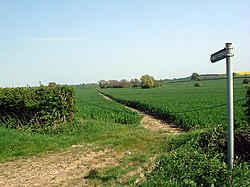Stodden Hundred: Difference between revisions
No edit summary |
No edit summary |
||
| Line 1: | Line 1: | ||
[[File:Footpath through cornfield - geograph.org.uk - 416265.jpg|right|thumb|250px|Field and footpath near Pertenhall]] | [[File:Footpath through cornfield - geograph.org.uk - 416265.jpg|right|thumb|250px|Field and footpath near Pertenhall]] | ||
The '''Stodden Hundred''' is one of the [[hundred]]s of [[Bedfordshire]], in the very north of the county, nestled against [[Northamptonshire]] ( | The '''Stodden Hundred''' is one of the [[hundred]]s of [[Bedfordshire]], in the very north of the county, nestled against [[Northamptonshire]] (to the north-west) and [[Huntingdonshire]] (to the north-east). | ||
The hundred contains the ancient parishes of: | The hundred contains the ancient parishes of: | ||
| Line 29: | Line 29: | ||
At the [[Domesday Book]] of 1086, this hundred was assessed at 99⅔ hides, valued at £146 15s, an increase since the £127 14s. 4d yield in the reign of Edward the Confessor. Included in these yield figures though estimate are 9 hides and 3 virgates, the subject of ten separate entries, under 'Estone', which J H Round identifies with Easton in Huntingdonshire and also 2½ hides and 1 virgate in [[Stanwick]] and [[Newton Bromswold]] respectively, both in Northamptonshire. Included also are 1 hide, 1 virgate in Elvendone, 1 hide in 'Hanefeld' and 1 virgate in 'Segresdone,' none of which places has been hitherto identified. | At the [[Domesday Book]] of 1086, this hundred was assessed at 99⅔ hides, valued at £146 15s, an increase since the £127 14s. 4d yield in the reign of Edward the Confessor. Included in these yield figures though estimate are 9 hides and 3 virgates, the subject of ten separate entries, under 'Estone', which J H Round identifies with Easton in Huntingdonshire and also 2½ hides and 1 virgate in [[Stanwick]] and [[Newton Bromswold]] respectively, both in Northamptonshire. Included also are 1 hide, 1 virgate in Elvendone, 1 hide in 'Hanefeld' and 1 virgate in 'Segresdone,' none of which places has been hitherto identified. | ||
Stodden was a royal hundred and remained in the hands of the Crown until Charles I in 1629–30 granted it to Gilbert North and his heirs to be held of the | Stodden was a royal hundred and remained in the hands of the Crown until Charles I in 1629–30 granted it to Gilbert North and his heirs to be held of the manor of East Greenwich for a yearly rent of £8 6s. In the time of the Commonwealth, Oliver St John Earl of Bolingbroke was lord of the hundred. The rights of the hundred have long since been in abeyance but in theory remained with the St John family, who have for centuries been the principal landowners within Stodden. | ||
==References== | ==References== | ||
Revision as of 17:40, 2 June 2017

The Stodden Hundred is one of the hundreds of Bedfordshire, in the very north of the county, nestled against Northamptonshire (to the north-west) and Huntingdonshire (to the north-east).
The hundred contains the ancient parishes of:
The boundaries of the hundred of Stodden are of an irregular character. The parishes of Clapham, Oakley and Milton Ernestare completely detached from the main portion, and the Huntingdonshire parish of Swineshead interjects itself west of Pertenhall.
At the Domesday Book of 1086, this hundred was assessed at 99⅔ hides, valued at £146 15s, an increase since the £127 14s. 4d yield in the reign of Edward the Confessor. Included in these yield figures though estimate are 9 hides and 3 virgates, the subject of ten separate entries, under 'Estone', which J H Round identifies with Easton in Huntingdonshire and also 2½ hides and 1 virgate in Stanwick and Newton Bromswold respectively, both in Northamptonshire. Included also are 1 hide, 1 virgate in Elvendone, 1 hide in 'Hanefeld' and 1 virgate in 'Segresdone,' none of which places has been hitherto identified.
Stodden was a royal hundred and remained in the hands of the Crown until Charles I in 1629–30 granted it to Gilbert North and his heirs to be held of the manor of East Greenwich for a yearly rent of £8 6s. In the time of the Commonwealth, Oliver St John Earl of Bolingbroke was lord of the hundred. The rights of the hundred have long since been in abeyance but in theory remained with the St John family, who have for centuries been the principal landowners within Stodden.
References
- 'The hundred of Stodden: Introduction' - A History of the County of Bedford: Volume 3 (1912), pp. 123
| Hundreds of Bedfordshire |
|---|
|
Barford • Biggleswade • Clifton • Flitt • Manshead • Redbournestoke • Stodden • Willey • Wixamtree |